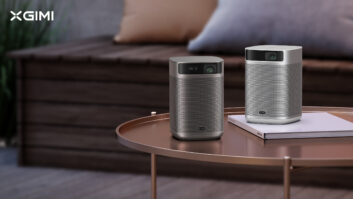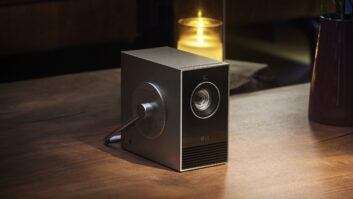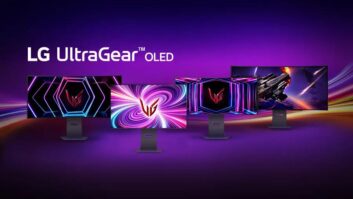Viewing the next two years as critical in the transition from analog to digital electronics products, LG Electronics will launch at CES the next phase of its dual-brand strategy for the LG and Zenith lines.
In a pre-show interview with TWICE, LG Electronics president T.J. Lee said his company is preparing to capitalize from a significant up-tick in the transition for analog to digital products in 2004 and 2005. Lee, who has completed his tenure in the U.S., will soon return to Korea after CES to be replaced by Michael Ahn in the president’s post.
Key growth segments for the industry and LG Electronics are flat-panel plasma and LCD technologies, as well as rear-projection models in both micro-device and traditional CRT-based varieties.
In plasma, the company expanded its production capacity in the second half of 2003, giving it a capacity of 700,000 pieces a year, Lee said. And the joint LG Philips LCD factory is stepping up production while developing some of the largest panels in the world.
Playing to these trends, LG Electronics will use its recently re-launched LG Electronics brand to mark new screen-size advances in plasma displays (71W- and 76W-inchs) and LCD TV (55W-inches), and will unveil what could be the first Blu-ray Disc recorders in the U.S. market.
In rear-projection television, LG will return to manufacturing CRT-based models at its Mexico factory, ending its OEM-customer relationship with Hitachi for those products. The company will also expand its lines of LCD-based rear-projection displays and is adding DLP models under both brands this year.
In source components, the company sees opportunities for new levels of digital recording and will introduce a range of DVRs and optical disc recorders based on standard-definition signal sources and the new Blu-ray disc high-definition recording format.
At the same time, the company is reaping the benefits of its significant investments in both plasma display and LCD TV factories. The company sees both technologies having a long, viable future even as screen sizes match up.
The company is trying to build the reputation of the LG brand as a high-tech innovator by being first to market with a range of next-generation devices. Lee said that with the present state of price erosion, “you had better be very fast with differentiated products to stay ahead of the competition. Fortunately, we have the capacity to do that.”
As for bringing those technologies to market, the company is moving to the second phase in the ramp up of its dual-brand strategy, using LG for premium product lines and Zenith for more mainstream channels.
“We want to introduce LG-branded products to a group of consumers we are calling the digital elite, focusing on higher-end products, that are life-style connoisseur focused,” explained Lee. “Zenith products will target the digital majority consumers.”
As the LG product line grows with more up-market goods, the Zenith line will be reshaped into a mid-tier to mainstream line “that is available to the newly growing digital population,” said Lee.
The LG launch began last summer, focusing on “more specialized home theater accounts. Gradually, we will move it into others, as well,” Lee said
“So far, the LG line has been wonderfully accepted by the dealers, and we are sheltering the brand for them,” he reported, adding that LG products cannot be sold on the Internet and include disciplined pricing policies. Eventually, the LG distribution target will be expanded to include other accounts, but not before it has a chance to be properly seated as a leader of innovation and performance.
Although LG has tried to establish its namesake brand in the U.S. in the past, those efforts were hampered by years of marketing as a promotional price line for mass merchants and other high-volume accounts. After pulling the GoldStar and LG brands out of the U.S. brown-goods business for several years, LG re-entered the business as the new parent of the Zenith brand, looking to build a new image as a technology innovator.
Lee said the LG Electronics brand enjoys a strong position in other world markets, and needs a presence in the U.S. In addition, Lee said the LG name enjoys a good reputation here as an innovator of cellphone technologies. The name is also getting a boost from a new push with innovative major appliances. Advertising across the different business sectors has created an enormous synergy from which each sector can equally benefit, Lee said.
Meanwhile, the LG-Philips’ LCD factory is the world’s largest supplier of LCD panels in the world for both LCD TVs and LCD PC monitors, according to Lee. It also has what he called the second-largest plasma panel manufacturing capacity, and “by 2005, we aspire to be No. 1, not only in terms of capacity but in terms of the technology.”
To help underscore these attributes, LG Electronics has started a strategic advertising campaign to support the LG brand in consumer magazines, and starting this month, will expand into television advertising with spots focused on plasma display and LCD TV. Additionally, the Zenith HDTV banners that now flash at the start of primetime television broadcasts on various networks, will soon begin to include the LG name, Lee said.
Lee said that LG has no plans to diminish the role of Zenth, as it strives to build the LG line. This year the Zenith line will handle 58 SKUs, while LG will handle 37.
“The market for the Digital Majority is growing very fast,” Lee said. “Zenith will be a good brand for those consumers. We have invested a lot in building the Zenith name over the last three years, and we think it has become very viable in the digital world.”
Now holding the patents on the 8-VSB modulation scheme used in the national digital television broadcasting standard, LG stands to benefit significantly from the Federal Communications Commission’s DTV tuner mandate, which begins a phased-in time line next year.
For its part, both LG and Zenith will follow two paths for complying with the mandate, Lee said. Some televisions will be offered with ATSC tuners only, while others will also include CableCARD slots for digital cable-TV plug-and-play compatibility.
In 2004, the company will offer five models incorporating both ATSC tuning and uni-directional CableCARD slots.
Long said that because of the FCC’s DTV tuner mandate, Zenith “may have an advantage over everybody else” delivering fully integrated products to market. This is particularly true in rear projection HDTV sets, where Zenith will have systems based on both micro-device engines and CRTs assembled in Mexico.
“We will use our strength in 8-VSB/ATSC tuning to make integrated tuning products, where some of our competitors might be challenged to get to the right price point,” Long said.
Lee said LG is producing LCD, CRT and PDP products in Mexico. “This will help us to quickly react to the market needs with quick deliveries to the U.S.,” he said.













